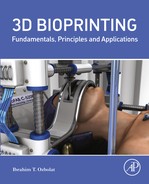Preface
Bioprinting is an emerging field that makes a revolutionary impact on medical sciences. It has attracted numerous researchers from various academic disciplines as well as the public. Bioprinting offers great precision on spatial placement of cells, proteins, DNA, drugs, and biologically active particles to better guide tissue generation and formation. This emerging technology appears to be more promising for advancing tissue engineering toward functional tissue and organ fabrication for transplantation, ultimately mitigating organ shortage and saving lives.
In this regard, development of a very comprehensive book covering all aspects of bioprinting is highly useful for the academic and educational circles, public, and the emerging bioprinting industry. The benefits of this book to the readership are in threefolds. First of all, the book is a unique source for academicians and researchers covering almost all aspects of bioprinting spanning raw materials, processes, machine technology, products, applications, limitations, and future perspectives. The growing research interest and the market in this field will make this book highly demandable. Secondly, it helps the bioengineers, tissue and manufacturing engineers as well as medical doctors to understand features of each bioprinting processes, the bioink and bioprinter type, and select the appropriate process for a given application such as tissue engineering and regenerative medicine, transplantation, clinics, or pharmaceutics. Thirdly, it is a great source for upper undergraduate- and graduate-level courses in the area of bioprinting, biofabrication, and tissue engineering considering the great worldwide interest on new undergraduate and graduate programs in biofabrication.
The book is outlined in 10 chapters including Introduction, Design for Bioprinting, The Bioink, Extrusion-Based Bioprinting, Droplet-Based Bioprinting, Laser-Based Bioprinting, Bioprinter Technologies, Roadmap to Organ Printing, Applications of 3D Bioprinting, and Future Trends.
Chapter 1 introduces tissue engineering, 3D printing in tissue engineering, principles of bioprinting and its components, and historical evaluation and classification of bioprinting processes. Chapter 2 discusses design for bioprinting covering the steps taken from medical imaging to bioprinting. Chapter 3 covers the bioink materials; their physical, chemical, and biological properties; compatible bioprinting techniques; and the comparison of bioink types.
In Chapters 4–6, the author discusses three major groups of bioprinting modalities including extrusion-, droplet-, and laser-based bioprinting, respectively. In each modality, the process and its characteristics and main components are described, the underlying physics is presented in addition to suitable bioink and cell types printed, and major accomplishments achieved so far.
In Chapter 7, bioprinter technologies are highlighted covering the components of bioprinters as well as the commercially available bioprinters in the market along with a detailed discussion on the limitations of bioprinter technologies. Chapter 8 covers the organ printing topic, introduces the state-of-the-art followed by the roadmap for organ printing with a step-by-step description. Chapter 9 presents the application areas of bioprinting, including tissue engineering and regenerative medicine, clinics and transplantation, pharmaceutics, and cancer research. Finally, Chapter 10 discusses the future trends in bioprinting that will revolutionize the organ transplantation technology in the next couple of decades.
..................Content has been hidden....................
You can't read the all page of ebook, please click here login for view all page.
